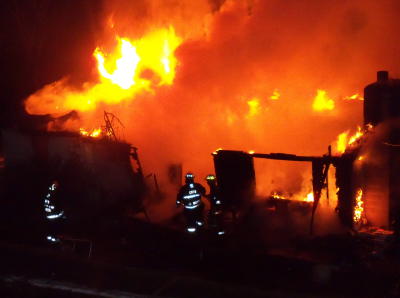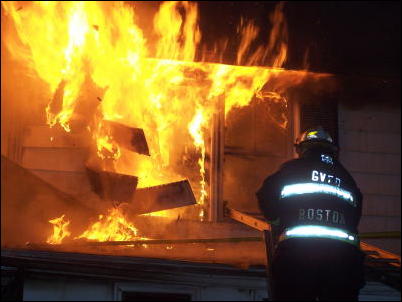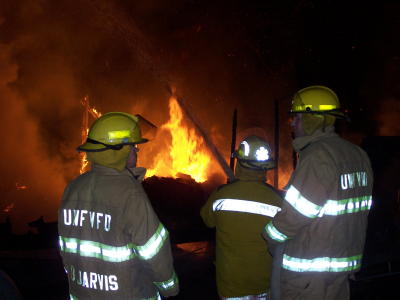CALHOUN'S FIRE DEPARTMENTS DEALING WITH CRISIS - Volunteerism Declines, Responses Are Hampered


Grantsville volunteer firemen on the job
By Bob Weaver
Volunteer fire departments, particularly in rural areas, are struggling to have enough trained responders because of a severe decline in volunteerism and increased standards for training.
Calhoun's three fire chiefs are expressing concern for the communities they serve, and are trying to come up with solutions.
A new response plan has been put in place to help with the problem.
Departments are facing critical problems over the lack of responders, particularly during daytime hours.
In addition to increased training requirements, some rural departments are facing financial woes, more recently with the proposed increase in Worker's Compensation payments, an increase that has been put on hold.
The cash-strapped WV Legislature, after considering a number of measures that would create incentives for volunteer firemen, have declined to act during past sessions.
More recently, they have deferred the problem to counties, who are equally cash-strapped.


Arnoldsburg and Upper West Fork Departments attack blazes
Calhoun's OES/E-911/LEPC Director Kathy Wood said there is a new policy regarding daytime response for Calhoun fire departments.
"It will be automatic that additional departments are dispatched to structure fires from 7 a.m. to 7 p.m.," Wood said.
Previously, fire departments requested mutual aid either enroute to a fire or after arrival.
"County fire chiefs have expressed real concern about the problem, and are working to do what is best for their communities," Wood said.
While in-county fire departments will quickly be used for mutual assistance, in some areas requests will be made for assistance from regional departments, like Elizabeth, Smithville, Big Otter and Spencer.
Calhoun departments will provide mutual aid to those fire departments when they are short on responders.
SHRINKING NUMBERS
In more populated WV counties, while the numbers of volunteers are also shrinking, there are still enough dedicated volunteers and responders to provide service.
Calhoun's three fire chiefs said the training requirements to be a firemen and maintain certification continues to increase, with state officials moving toward training volunteers at the same level as professional, paid firemen.
Several hundred hours of training is required over a period of time to be a volunteer firemen and maintain status, with additional credentialing courses continuing to be added for special situations.
Just for starters, a firefighter must be trained with Firefighter I, Hazardous Materials Awareness, First Aid and CPR.
Additional training is required, with 50% of all volunteers in a department completing Firefighter 2, all company officers must complete Fire Officer I, and all Chief Officers must complete Fire Officer II by May 1, 2011.
Most of the training requires weekend attendance.
Grantsville Fire Chief Craig Gherke said, "It's getting worse," referring to problems related to recruitment and responding.
"I know the public can get upset, but our firemen are equally upset when we have a poor response," Gherke said.
"Most of our volunteers work day jobs, most of them out of the county," said Arnoldsburg Fire Chief Derek Wright.
"It's a real struggle for our members to keep up the training, answer calls, work and be with their families," said Wright.
Both Gherke and Wright said their dedicated firemen are getting older, and few young people are in the wings to replace them.
Upper West Fork VFD Chief Randy Perkins, who has long expressed concern that excessive mandated requirements could put volunteer fire departments out of business, said, "We've been able to retain a number of younger members, but many of them work out of county."
"You have to take classes, or lose state money," he said.
"I think training is essential, but firemen could take in-house training after the basic courses," Perkins said.
All the fire chiefs said they're looking for volunteers.
IMPORTANCE OF VOLUNTEER FIRE DEPARTMENTS
At one time, volunteer firemen mostly went on fire calls.
Over the years, the menu of what firemen do to help the community has greatly expanded.
Firemen have become first responders for natural disasters, car wrecks, rescues, searches, traffic control, brush fires, medical emergencies, lifting assistance, helicopter life-flights and many other situations.
There is a high dependence on the departments, at a moments notice.
Additionally, insurance companies rate their fire insurance premiums based on the availability of fire services and water hydrants.
Without the fire departments in proximity to the property owner, insurance costs immediately go the highest rate.